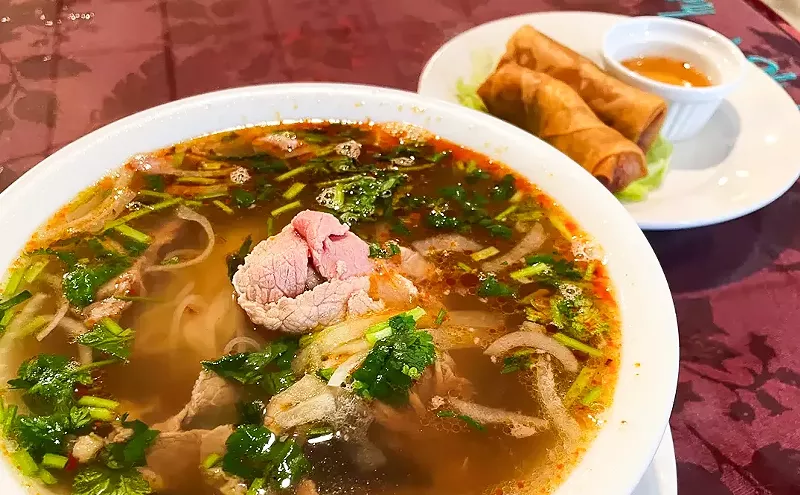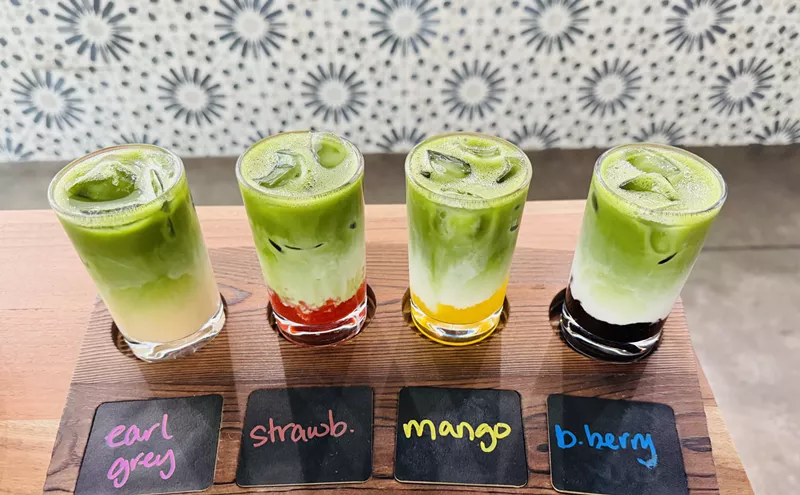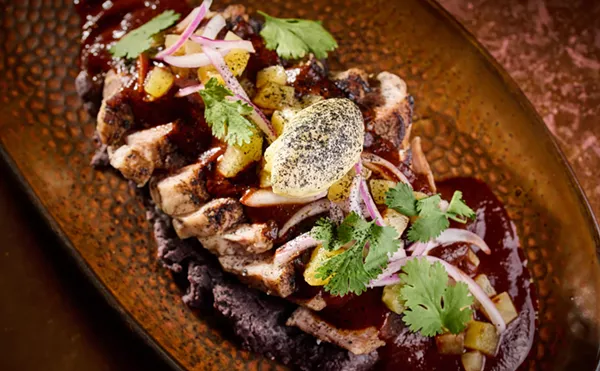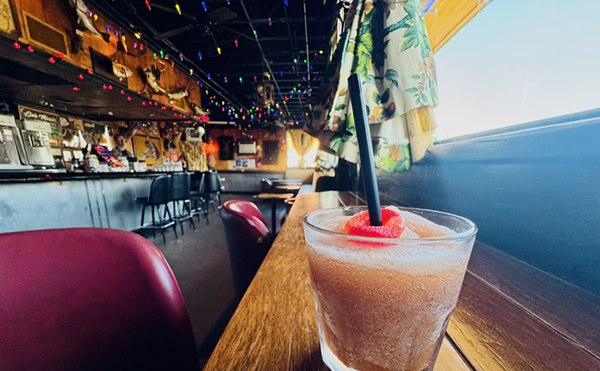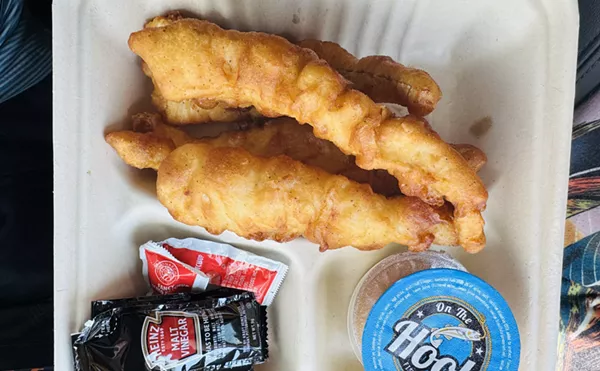Zen has something in it which makes it stand aloof from the scene of worldly sordidness and restlessness."
—D.T. Suzuki, May 1953
What strikes you immediately is its rigorous simplicity. Zen Sushi isn't simmering a scene or riding a trend. It has clean, near-barren walls and stark wood tables and chairs fit for punishments in the corner. Duck-billed soy bottles with bright red bellies and chopsticks enveloped in meticulously folded napkins line the Spartan surfaces. Small abutments in the walls hold vases with single blossoms stretching from long stems. Up higher, nudging the tin ceiling, are rows of loudspeakers and sound baffling above the suspended ceiling to dampen the noise that some mistake for social vitality. Gauzy curtains waver sensuously in the rear, perhaps so that the simple sushi bar cases and wooden racks and slots behind them with bottles and dishes and cups don't seem so stridently utilitarian. But what comes out...
Michelle Carpenter has been preparing this moment for close to two decades, some of the time in San Diego, much of it at Yamaguchi's on Inwood Road where Shinsei now reigns. "I like the simple," she says. "Food should be simple and served in a simple manner instead of with 30 or 40 ingredients thrown together so that you really can't figure out the tastes."
Simple never means easy. Sushi craftsmanship demands mastery of exacting details until the flurry of blades on flesh becomes effortless. At the end of the sushi bar is a pulpit to such craft, a space where Carpenter turns this mastery into performance art: the omakase dinner. Omakase means to entrust, and traditionally the omakase onegaishimasu is an experience that grants chefs the authority to indulge whims. Carpenter's omakase must be ordered at least 24 hours in advance, preferably 48. She shops the day of, gathering whatever seems freshest. You'll have no idea what you'll be eating. You'll pay $100 per person for the privilege—an expensive blind date under the knife. Carpenter might take a 4-pound snapper and prepare it four ways: ceviche, sashimi, stuffed and baked, and picked-over head and skeleton fried for feasting on the collar. Frills might be Kobe beef sushi, an exotic mushroom composition and a special roll she intuits from your preferences. This culinary intimacy is prepared right in front of you. No refrigerated sushi case or ledge blocks this pulpit.
To traditional Japanese craft Carpenter—like so many chefs in these parts—adds sharp Southwestern strokes: cilantro, lime, jalapeño. There is ceviche with snapper, sole or halibut frilled with cucumber, cilantro and tobiko. She quick-blanches her fish in lime for 90 seconds before steeping it in a martini glass in a bath of lime and ponzu. Wonton chips stunt-double for tortilla chips.
She blisters bok choy lavished in garlic and butter with a secret seasoning that reeks of Southwestern capsicum. Resting on a platter with the yakitori sampler—skewers of asparagus bound in bacon, chicken meshed with mushroom, beef seared to scallion and scallops—is a white soup spoon brimming with salsa: chopped mango, jalapeño and scallion that flirts as much with its bright color as it does its perfumey sweetness.
Before me are two plates: spindly nuggets of coconut panko lobster with plum sauce and panko-fried oysters with "bulldog sauce," or tonkatsu, a tomato-based soy condiment with the pungent vigor of Worcestershire. Each is crisp and greaseless. Musky oyster merges seamlessly with the bulldog sauce, but what of the lobster? It's bewildering why so many chefs seem driven to blur or obliterate the sly richness of lobster meat with deep-frying and cloying condiments. Ponder the nonsense of it.
To my left is a little girl with long brown hair and eyes as big and gleaming as fresh oysters. Next to her is a man in a bulky sweatshirt and a baseball cap. "Bullshit" pops from one of his sentences. The little girl holds up seven fingers: the number of dollars he owes her for his reflexive cussing. Bullshit marked the seventh dollar.
The man in the baseball cap and sweatshirt is Tony Militello, Carpenter's financial backer. "She's the only reason I'm in this business," he insists, aiming his index finger at her as she slices tuna from behind the bar, a faded orange Texas cap on her head. This business is far afield from his. Militello runs an audio-visual design firm. He laments the demise of stereos and evocative, high-fidelity music experiences over sashimi. He grumbles over the conquest of McIntosh Audio amplifiers by Macintosh computers and the scourge of sonically inferior iPod digitization.
Yet it's hard to keep a keen focus on anything but food when eating Carpenter's dishes. Her sushi is impeccable: cool, smooth, silken, like eating finely woven spring water over rice. She carves strips of Spanish mackerel from a whole silvery fish that seemingly grins. She builds gentle hillocks of bright fluffy tobiko. She drapes tongues of uni (sea urchin) over barren billets of rice. Carpenter eschews nori—the dried seaweed strip binding the rice—when the uni is exceptionally fresh and firm, not wanting to cloud the flavors.
She drapes layers of this freshest flesh in uni bellini, a martini glass of sake suspending cucumber, salmon roe and a single quail egg that hovers over everything like a jaundiced globe. She turns baby octopus into fluffy popcorn morsels by coating it in cornstarch and serving it with a spicy ponzu sauce. Her miso soup is a rich whorl of deep flavors and sensual tics: loops of steam with a slight fermented stink, tiny cubes of tofu as soft as mozzarella, wispy rings of scallion orbiting undulating ribbons of wakami seaweed.
Slick buttery flakes peel from the miso-marinated black cod, collapsing into limp flaps at the slightest prod of the chopstick. A slight crispness gives them pithiness.
You can finish with a tango of tempura mango and tempura banana dribbled with honey and feel the mushed tropical acids rail against hushed tropical sweetness, both stiffened for the clash with brittle tempura. Militello insists Zen is the Oak Cliff equivalent of Tei Tei Robata Bar. That may be overstating things. But certainly not by much.
Zen Sushi, 380 W. 7th St., Bishop Arts District, 214-946-9699. Open 11:30 a.m.-2:30 p.m. Monday-Saturday, 5:30 p.m.-10 p.m. Monday-Thursday, 5:30 p.m.-11 p.m. Friday and Saturday. $$$-$$$$



